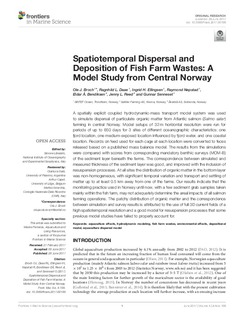| dc.contributor.author | Broch, Ole Jacob | |
| dc.contributor.author | Daae, Ragnhild Lundmark | |
| dc.contributor.author | Ellingsen, Ingrid H. | |
| dc.contributor.author | Nepstad, Raymond | |
| dc.contributor.author | Bendiksen, Eldar Åsgard | |
| dc.contributor.author | Reed, Jenny Lisa | |
| dc.contributor.author | Senneset, Gunnar | |
| dc.date.accessioned | 2017-11-09T13:27:22Z | |
| dc.date.available | 2017-11-09T13:27:22Z | |
| dc.date.created | 2017-11-07T12:59:10Z | |
| dc.date.issued | 2017-06-28 | |
| dc.identifier.issn | 2296-7745 | |
| dc.identifier.uri | http://hdl.handle.net/11250/2465297 | |
| dc.description.abstract | A spatially explicit coupled hydrodynamic-mass transport model system was used to simulate dispersal of particulate organic matter from Atlantic salmon (Salmo salar) farming in central Norway. Model setups of 32 m horizontal resolution were run for periods of up to 650 days for 3 sites of different oceanographic characteristics: one fjord location, one medium-exposed location influenced by fjord water, and one coastal location. Records on feed used for each cage at each location were converted to feces released based on a published mass balance model. The results from the simulations were compared with scores from corresponding mandatory benthic surveys (MOM-B) of the sediment layer beneath the farms. The correspondence between simulated and measured thickness of the sediment layer was good, and improved with the inclusion of resuspension processes. At all sites the distribution of organic matter in the bottom layer was non-homogeneous, with significant temporal variation and transport and settling of matter up to at least 0.5 km away from one of the farms. Our results indicate that the monitoring practice used in Norway until now, with a few sediment grab samples taken mainly within the fish farm, may not adequately determine the areal impacts of all salmon farming operations. The patchy distribution of organic matter and the correspondence between simulation and survey results is attributed to the use of full 3D current fields of a high spatiotemporal resolution and a good model for resuspension processes that some previous model studies have failed to properly account for. | nb_NO |
| dc.language.iso | eng | nb_NO |
| dc.relation.uri | https://www.frontiersin.org/articles/10.3389/fmars.2017.00199/full | |
| dc.rights | Navngivelse-Ikkekommersiell-DelPåSammeVilkår 4.0 Internasjonal | * |
| dc.rights.uri | http://creativecommons.org/licenses/by-nc-sa/4.0/deed.no | * |
| dc.subject | aquaculture effects | nb_NO |
| dc.subject | hydrodynamic modeling | nb_NO |
| dc.subject | fish farm wastes | nb_NO |
| dc.subject | environmental effects | nb_NO |
| dc.subject | depositional model | nb_NO |
| dc.subject | aquaculture dispersal model | nb_NO |
| dc.title | Spatiotemporal Dispersal and Deposition of Fish Farm Wastes: A Model Study from Central Norway | nb_NO |
| dc.type | Journal article | nb_NO |
| dc.type | Peer reviewed | nb_NO |
| dc.description.version | publishedVersion | nb_NO |
| dc.rights.holder | Copyright © 2017 Broch, Daae, Ellingsen, Nepstad, Bendiksen, Reed and Senneset. This is an open-access article distributed under the terms of the Creative Commons Attribution License (CC BY). The use, distribution or reproduction in other forums is permitted, provided the original author(s) or licensor are credited and that the original publication in this journal is cited, in accordance with accepted academic practice. No use, distribution or reproduction is permitted which does not comply with these terms | nb_NO |
| dc.source.volume | 4 | nb_NO |
| dc.source.journal | Frontiers in Marine Science | nb_NO |
| dc.identifier.doi | 10.3389/fmars.2017.00199 | |
| dc.identifier.cristin | 1511796 | |
| dc.relation.project | Notur/NorStore: 2967k | nb_NO |
| cristin.unitcode | 7566,4,0,0 | |
| cristin.unitcode | 7566,6,0,0 | |
| cristin.unitcode | 7566,3,0,0 | |
| cristin.unitname | Marin Ressursteknologi | |
| cristin.unitname | Miljøteknologi | |
| cristin.unitname | Havbruksteknologi | |
| cristin.ispublished | true | |
| cristin.fulltext | original | |
| cristin.qualitycode | 1 | |

